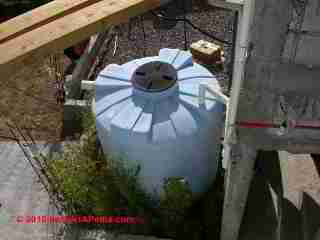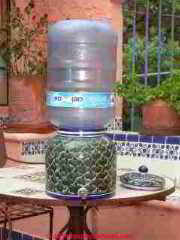 Plastic & Resin number code guide: Plastic Bottles, Containers, Tanks Plastic Types, Plastic Contaminants
Plastic & Resin number code guide: Plastic Bottles, Containers, Tanks Plastic Types, Plastic Contaminants
- POST a QUESTION or COMMENT about the different kinds of plastic used to make bottles and containers; how to identify different plastic types.
What do the different recycling number codes on plastic products mean:
Here we provide a key to plastic resin identification codes and we provide photographs of the number codes, a description of the type of plastic each represents, and photos of typical plastic containers of each type.
Plastic bottles, containers, tanks: this article describes the types of plastics used in bottles, containers, and tanks, including for water storage, cisterns, and other liquids. We identify possible contaminants that may leach into drinking water from some types of plastic.
InspectAPedia tolerates no conflicts of interest. We have no relationship with advertisers, products, or services discussed at this website.
- Daniel Friedman, Publisher/Editor/Author - See WHO ARE WE?
Types of Plastics Used for Bottles, Containers & Tanks
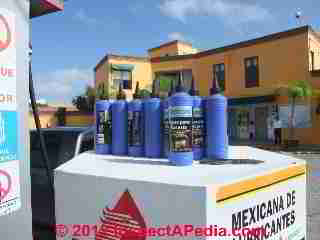
- HDPE - High Density Polyethylene - the most widely used material for plastic bottles, HDPE is supplied in FDA-approved food-grade products. It does not withstand temperatures over 160 degF. Don't assume that HDPE containers are all clear or white. HDPE containers are commonly found in a variety of colors: white, red, blue, green, gray, etc.
Our photo (left) illustrates a use of HDPE polyethylene plastic bottles used to contain battery acid at a gas stop in San Miguel de Allende, Mexico. Also see PLASTIC & FIBERGLASS TANKS, HDPE. - K-SBC - K-Resin SBC plastic containers, a styrene derivative, used for containers but not for oils or solvents.
- LDPE - Low Density Polyethylene - similar to HDPE, less rigid, more translucent, more costly, not used for water storage tanks.
- PCR - Post-Consumer Resin, reclaimed plastic HDPE storage containers.
- Polycarbonate plastic containers made with biphenyl-A (a hormone disruptor)(baby bottles, microwave ovenware, eating utensils)
- PET - Polyethylene terephthalate (PETE, PETP, PET-P) is a thermoplastic polymer polyester plastic resin. plastic water tanks may be a health risk to consumers
- PP - Polypropylene plastic storage containers, used for foods, tolerates higher temperatures.
- PS - Polystyrene plastic storage containers, used with dry products, not for water storage.
- PVC - Polyvinyl Chloride plastic bottles or storage tanks, used for bottled oils and soaps, like HDPE it does not withstand high temperatures over 160 degF.
So What Plastic Was Used to Make My Water Bottle, Container, or Water Tank?
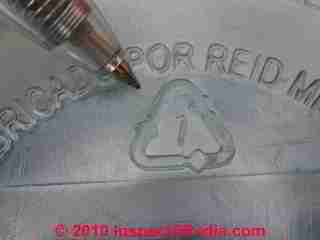
How to Use the Plastic Recycling Code to Identify The Type of Plastic Tank or Container
How do you identify what kind of plastic was used to make your water or other storage tank or even your plastic water bottle or food container?
Use this simple guide to plastic recycling codes and look for the recycling indicator or label on your plastic container. Our photo (left) shows an image of the plastic recycling code #7.
Guide to Plastic & Resin Recycling Number Codes | |||
 |
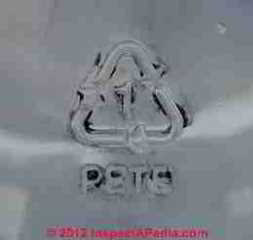 |
#1 code plastics - PET / PETE (polyethylene terephthalate) One-time use (do not refill plastic water bottles carrying this recycling mark). See our plastic water storage tank, plastic Ethos water bottle photos and details below. Very wide range of use for liquids, other. Household cleaners in clear bottles. M&H Plastics points out that "PET containers require special consideration during warm weather in order to prevent shrinkage or distortion occurring after the molding process is completed." The company provides additional details including an interesting oxygen-scavenging PET innovation useful for packaging foods that deteriorate in the presence of oxygen.[10] |
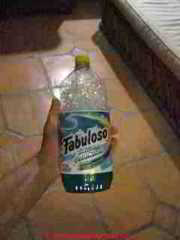 |
 |
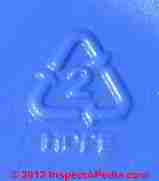 |
#2 code plastics - HDPE (high density polyethylene) (Nalgene Corp. produces HDPE water bottles) - also see PLASTIC & FIBERGLASS TANKS, HDPE Very wide range of use for liquids, solids, pastes |
 |
 |
#3 number code plastics - PVC (polyvinyl chloride). Watch out: a little confusing is that plastic bottle manufacturers may describe bottle categories as "PETG/PCTG/PVC bottles" [10] |
||
 |
#4 code plastics - LDPE (low density polyethylene | ||
 |
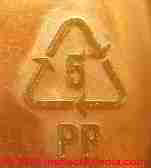 |
#5 plastics - PP (polypropylene) Typical examples: tan, translucent prescription bottles; plastic deodorant containers (shown at right) |
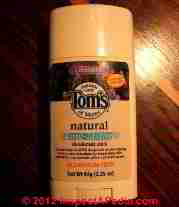 |
 |
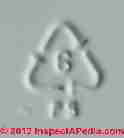 |
#6 plastics - PS (polystyrene) - example, white plastic coffee cup lid at left Watch out: on some products the "6" plastic resin identification code may look like an "8" - not to worry, the plastic identification codes are numbers 1-7: if it looks like an "8" it's probably a "6". |
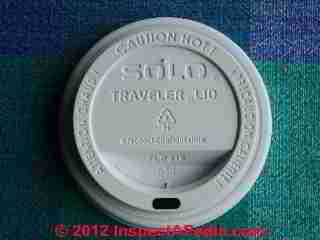 |
 |
 |
#7 plastics - Plastics-other (includes polycarbonate plastics) FYI: while BPA-containing plastic containers are expected to carry the #7 recycling label, according to the New York Times (7 Sept. 2010), not all plastics labeled with recycling symbol #7 are in fact BPA-containing.[7] Watch out:On some containers it is tricky to distinguish between a "7" plastic code and a "1" PLASTIC CODE. |
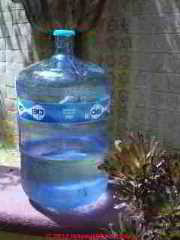 |
...
Key to Other Plastic Container & Packaging Abbreviations |
|
|---|---|
| Biodegradable plastic products |
Generally products made using plastics made of polymer chains that break down to become brittle in certain environments, such as under exposure to UV in sunlight, or under exposure to oxygen, typically within a 5-year time frame. Note that products that break down into tiny fragments are not in all cases environmentally sound - such as certain ultra-fine plastic fragments found in some ocean areas and on some coasts, and in seawater. |
| PCR | Post-consumer regrind, recycled plastic products that are re-processed and re-used in manufacturing |
| PIR | Post-industrial regrind, as above, but using plastic waste products recovered from industrial processes, often used to produce container caps and also some jars. |
| PLA | Polylactic acid plastic products are plastic products made using corn starch rather than petroleum products as their chemical base |
PET Plastic Water Storage Tank Health, Safety, & Sanitation Advice
I've been unable to find on-line information about the safety of using common 1500 gallon plastic water tanks to hold drinking water. Our tank is shaded, but summers are warm and the water often sits in the tank for weeks, especially when we are traveling.
Our tank is 20 years old, but according to web sites now selling drinking water tanks, the plastic is polyethylene terephthalate aka PET.
To my knowledge, we haven't had any problems to date with bacteria growing. I don't taste plastic. We once had a mouse get in and die. Bad smelling water. It cleared up after a few weeks. Probably drank some of it!
Do you have any information or links? - Barbara Stuart
The above-ground water cistern storage tank shown in our photo (above left) is located in San Miguel de Allende, Mexico and is discussed at PASSIVE SOLAR HOME, LOW COST.
Answer:
 As Ms. Stuart pointed out, some water storage tanks are made of plastic polyethylene terephthalate aka PET. Polyethylene Terephthalate (PET, PETE or polyester) is commonly used for carbonated beverage and water bottles intended for one time use - not a plastic one would expect use for a water storage tank.
As Ms. Stuart pointed out, some water storage tanks are made of plastic polyethylene terephthalate aka PET. Polyethylene Terephthalate (PET, PETE or polyester) is commonly used for carbonated beverage and water bottles intended for one time use - not a plastic one would expect use for a water storage tank.
But some water storage tanks have also been constructed of PETE material.
Our photo (left) illustrates a water bottle produced using polyethylene terephthalate.
PET - Polyethylene terephthalate (PETE, PETP, PET-P) is a thermoplastic polymer polyester plastic resin.
Plastic water tanks may be a health risk to consumers:
Commentary published in Environmental Health Perspectives in April 2010 suggested that PET might yield endocrine disruptors under conditions of common use and recommended research on this topic.
Proposed mechanisms include leaching of phthalates as well as leaching of antimony.
Other authors have published evidence indicating that it is quite unlikely that PET yields endocrine disruptors. - Web search 6/27/2010 Wikipedia. PET
Sorting Through the Confusion of Opinions vs. Studies About Plastic Container Materials, Names, Hazards
 Researching the health hazards of plastic containers and asking which plastics are safe can give conflicting and confusing results.
Researching the health hazards of plastic containers and asking which plastics are safe can give conflicting and confusing results.
Our photo (left) provides a close-up of the #1 recycling code and the PETE indicator for polyethylene terephthalate embossed into the bottom of the plastic water bottle illustrated above.
Some sources such as the "green" website Care2.com assert that PET or PETE polyethylene terephthalate and HDPE high density polyethylene plastic containers are "GOOD: Not known to leach any chemicals that are suspected of causing cancer or disrupting hormones.".
These same sources may tag LDPE, PP, PS as "OK", and tagging PVC or V and PS as "BAD - PVC - According to the National Institutes of Health, di-2-ethylhexyl phthalate (DEHP), commonly found in PVC, is a suspected human carcinogen., and BAD PS - According to the National Institutes of Health, di-2-ethylhexyl phthalate (DEHP), commonly found in PVC, is a suspected human carcinogen." - Web search 06/30/2010 care2.com.
There is also confusion about "polyethylene plastic" bottles and tanks. Don't confuse HDPE plastic (high density polyethylene) with PET - Polyethylene terephthalate (PETE, PETP, PET-P) - see What Plastic Was Used to Make My Water Tank (or water bottle)?
Looking at more expert researchers commenting on PET plastic containers:
But recently researchers have raised serious questions about potential health and environmental concerns for PET or PETE plastics. At Reviewers & References see Sax L 2010, López-Carrillo L, et als 2010, Koike E, 2010, for examples.
In April 2010 Environmental Health Perspectives, a peer-reviewed open access journal published by the National Institute of Environmental Health Sciences, Saxreported that
Polyethylene terephthalate (PET) is widely used to make clear plastic bottles for bottled water and containers for other beverages, condiments, and cosmetic products. There is concern that estrogenic chemicals such as phthalates may leach into the contents from bottles made from PET, although PET is not a phthalate derivative. Sax (p. 445) describes several studies suggesting that water from PET bottles can have estrogenic activity in some bioassays and that phthalates might leach from PET bottles.
The author notes the difficulties in evaluating these studies, especially in cases where there may have been prior contamination of the water or the containers with estrogenic agents or phthalates. Sax suggests that the phthalate content of PET bottles, if present, might vary as a function of the acidity of the product and the temperature and duration of storage.
Sax also makes the observation that other nonphthalate chemicals such as antimony, which is used as a catalyst in the polycondensation of PET, might also contribute to the endocrine-disrupting activity of products stored in PET containers. The widespread use of PET plastic for a variety of applications suggests that additional research is needed.
The contents of the PET bottle, and the temperature at which it is stored, both appear to influence the rate and magnitude of leaching. Endocrine disruptors other than phthalates, specifically antimony, may also contribute to the endocrine-disrupting effect of water from PET containers.
Conclusions: More research is needed in order to clarify the mechanisms whereby beverages and condiments in PET containers may be contaminated by endocrine-disrupting chemicals.
If your water storage tank is made from Polyethylene terephthalate (PET), and is exposed to high temperatures such as exposure to direct sun and/or in a hot climate, the health risk may be increased. AtReferences or Citations , below, we include citations of several recent articles discussing health risks from Phthalates and PET containers.
Find Your Water Tank Plastic Type from the Manufacturer's Literature, Website, or Sales Support
Watch out: some plastic water storage tank distributors advertise that their tanks comply with some health and sanitation laws while omitting any comment about the type of plastic or possible PET concerns (see below). For example we found plastic water tanks advertised as
Specified IW series water tanks manufactured at Chem-Tainer's Compton, California factory are IAPMO certified to comply with the California Lead Plumbing Law and NSF/ ANSI 61- ANNEX G. This law states that any devices or components sold in the state of California that come in contact with potable water must comply with this law.
But it's easy to check the manufacturer's website or to ask the plastic water tank manufacturer for specifics of the plastics used. For example, Chem-Tainer Industries, a producer of a very wide range of plastic storage tanks indicates that
Chem-Tainer's fresh water tanks are an effective, economical way to store potable (drinking) water for Residential and Commercial applications. Our polyethylene resin complies with U.S. Food and Drug Administration regulation 21CFR 177.1520 (1) 3.1 and 3.2 for storage of potable water. These tanks are designed for water use only.
BPA - Bisphenol-A - containing Plastics: A Quick Summary on Endocrine Disruptors
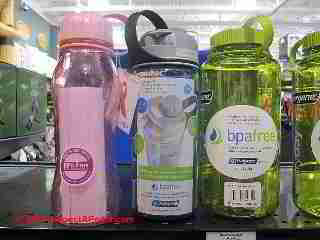 Details about BPA plastics in food and liquid containers are found at Bisphenol-A, BPA. Excerpts are below.
Details about BPA plastics in food and liquid containers are found at Bisphenol-A, BPA. Excerpts are below.
According to the New York Times (7 Sept 2010)
Concerns about BPA stem from studies in lab animals and cell cultures showing that it can mimic the hormone estrogen. It is considered an "endocrine disruptor," a term applied to chemicals that can act like hormones. But whether it does any harm to people is unclear.
About half a dozen [U.S.] states have banned BPA in children's products
... This year a presidential panel on cancer and the environment said there was a "growing link" between BPA and several diseases, including cancer, and recommended ways to avoid BPA, like storing water in bottles free of it and not microwaving food in plastic containers.
Some cancer experts said the report overstated the case against chemicals, but the concerns it raised seem to reflect growing public worries.
...
Continue reading at ENDOCRINE DISRUPTERS at BUILDINGS or select a topic from the closely-related articles below, or see the complete ARTICLE INDEX.
Also see these
Recommended Articles
- Bisphenol-A, BPA
- PLASTIC & FIBERGLASS TANKS, HDPE
- PLASTIC PLEXVENT ULTRAVENT RECALL
- PLASTIC PIPING ABS CPVC PB PEX PPR PVC
- WATER TANK SAFETY
Suggested citation for this web page
PLASTIC RECYCLING CODES, TANKS, TYPES at InspectApedia.com - online encyclopedia of building & environmental inspection, testing, diagnosis, repair, & problem prevention advice.
Or see this
INDEX to RELATED ARTICLES: ARTICLE INDEX to BUILDING ENVIRONMENT
Or use the SEARCH BOX found below to Ask a Question or Search InspectApedia
Ask a Question or Search InspectApedia
Questions & answers or comments about finding, using, diagnosing, repairing, or replacing water pressure gauges on private well systems.
Try the search box just below, or if you prefer, post a question or comment in the Comments box below and we will respond promptly.
Search the InspectApedia website
Note: appearance of your Comment below may be delayed: if your comment contains an image, photograph, web link, or text that looks to the software as if it might be a web link, your posting will appear after it has been approved by a moderator. Apologies for the delay.
Only one image can be added per comment but you can post as many comments, and therefore images, as you like.
You will not receive a notification when a response to your question has been posted.
Please bookmark this page to make it easy for you to check back for our response.
IF above you see "Comment Form is loading comments..." then COMMENT BOX - countable.ca / bawkbox.com IS NOT WORKING.
In any case you are welcome to send an email directly to us at InspectApedia.com at editor@inspectApedia.com
We'll reply to you directly. Please help us help you by noting, in your email, the URL of the InspectApedia page where you wanted to comment.
Citations & References
In addition to any citations in the article above, a full list is available on request.
- [1] Thanks to reader Barbara Stuart for discussing water storage tank sanitation and concerns for PET plastic water storage tanks - June 2010.
- [2] Barrett JR 2010. Attention-Worthy Association: Prenatal Phthalate Exposure and Later Child Behavior. Environ Health Perspect 118:a172-a172. doi:10.1289/ehp.118-a172b, Online: 01 April 2010 - Polybrominated Diphenyl Ethers Induce Developmental Neurotoxicity in a Human in Vitro Model: Evidence for Endocrine Disruption
Web search 06/30/2010, original source: http://ehp03.niehs.nih.gov/article/fetchArticle.action?
articleURI=info%3Adoi%2F10.1289%2Fehp.118-a172b
Quoting:
Human exposure to phthalates is ubiquitous due to widespread commercial use. Although the compounds are reported to be rapidly metabolized, concentrations in the body appear to remain fairly stable due to ongoing exposure. The United States and Europe have banned some phthalates from consumer products primarily on the basis of reproductive toxicity data. However, not all phthalates are regulated; meanwhile, research indicates toxicity may extend to other endocrine targets such as the thyroid gland, which is critical for proper neurodevelopment. A new study now reports an association between prenatal exposure to certain phthalates and adverse effects on test scores used to evaluate children’s behavior and executive functioning [EHP 118:565–571; Engel et al.]. - [3] Chem-Tainer Industries, 361 Neptune Avenue, West Babylon, NY 11704, Phone: (631) 661-8300, Toll Free: 1-800-ASK-CHEM, Chem-Tainer Representatives are available 8 AM - 8 PM Eastern Time Fax: (631) 661-8209800-275-2436, Email: sales@chemtainer.com - Web Search 06/30/2010, original source: http://www.chemtainer.com/watertanks/vertical.aspx
- [4] Sax L 2010. Polyethylene Terephthalate May Yield Endocrine Disruptors. Environ Health Perspect 118:445-448. doi:10.1289/ehp.0901253, Web Search 06/30/2010 original source: http://ehp03.niehs.nih.gov/article/fetchArticle.action?article
URI=info%3Adoi%2F10.1289%2Fehp.0901253
Polyethylene terephthalate (PET) is widely used to make clear plastic bottles for bottled water and containers for other beverages, condiments, and cosmetic products. There is concern that estrogenic chemicals such as phthalates may leach into the contents from bottles made from PET, although PET is not a phthalate derivative. Sax (p. 445) describes several studies suggesting that water from PET bottles can have estrogenic activity in some bioassays and that phthalates might leach from PET bottles. The author notes the difficulties in evaluating these studies, especially in cases where there may have been prior contamination of the water or the containers with estrogenic agents or phthalates. Sax suggests that the phthalate content of PET bottles, if present, might vary as a function of the acidity of the product and the temperature and duration of storage. Sax also makes the observation that other nonphthalate chemicals such as antimony, which is used as a catalyst in the polycondensation of PET, might also contribute to the endocrine-disrupting activity of products stored in PET containers. The widespread use of PET plastic for a variety of applications suggests that additional research is needed. - [5] López-Carrillo L, Hernández-Ramírez RU, Calafat AM, Torres-Sánchez L, Galván-Portillo M, Needham LL, et al. 2010. Exposure to Phthalates and Breast Cancer Risk in Northern Mexico. Environ Health Perspect 118:539-544. doi:10.1289/ehp.0901091
Web Search 06/30/2010, original source: http://ehp03.niehs.nih.gov/article/fetchArticle.action?articleURI=info%3Adoi%2F10.1289%2Fehp.0901091
Keywords: breast cancer, case–control study, endocrine disruptors, environment, Mexico, phthalates, risk assessment, urinary metabolites.
Quoting:
Conclusions: We show for the first time that exposure to diethyl phthalate, the parent compound of MEP, may be associated with increased risk of BC [breast cancer], whereas exposure to the parent phthalates of MBzP and MCPP might be negatively associated. These findings require confirmation.
Quoting the Editor's Summary:
Phthalates are ubiquitous environmental pollutants used primarily as plasticizers of polyvinyl chloride and as additives in consumer and personal care products. Research has shown that phthalates can have effects on reproductive health and development. Few studies have investigated potential adverse effects of phthalates in women. In a population-based case–control study, López-Carrillo et al. (p. 539) examined the association between urinary concentrations of nine phthalate metabolites and breast cancer. Phthalate metabolites were detected in urine samples in at least 82% of women. The geometric mean concentrations of monoethyl phthalate (MEP) were higher in cases than controls, whereas controls had significantly higher concentrations of mono-n-butyl phthalate, mono(2-ethyl-5-oxohexyl) phthalate, and mono(3-carboxypropyl) phthalate (MCPP) than cases. After adjusting for risk factors and other phthalates, urinary concentrations of MEP were positively associated with breast cancer, and the association was stronger among premenopausal women. In contrast, there were significant negative associations between monobenzyl phthalate (MBzP) or MCPP and breast cancer. - [6] Koike E, Yanagisawa R, Sadakane K, Inoue K-i, Ichinose T, Takano H 2010. Effects of Diisononyl Phthalate on Atopic Dermatitis in Vivo and Immunologic Responses in Vitro. Environ Health Perspect 118:472-478. doi:10.1289/ehp.0901255 - Web Search 06/30/2010, original source: http://ehp03.niehs.nih.gov/article/fetchArticle.action?articleURI=info%3Adoi%2F10.1289%2Fehp.0901255
Diisononyl phthalate (DINP), a principal plasticizer in many polyvinyl chloride products, has been shown to have an adjuvant effect on immunoglobulin (Ig) production in mice. However, the effects of DINP on allergic diseases have not been fully elucidated.
Conclusions: DINP can aggravate AD-like skin lesions related to Dp. The mechanisms of the aggravation might be mediated, at least partly, through the TSLP-related activation of dendritic cells and by direct or indirect activation of the immune cells.
Quoting Editor's Summary
Epidemiologic studies have suggested that exposure to phthalate esters such as di-isononyl phthalate (DINP) may be associated with the development of asthma, wheezing, and allergic symptoms. Koike et al. (p. 472) investigated the effects of DINP on the development of another allergic disease, atopic dermatitis. These investigators induced atopic dermatitis experimentally in laboratory animals and then exposed the mice systemically to various doses of DINP for up to 16 days. Clinical scores, histology, protein level of cytokines and chemokines in ear tissue supernatants, and levels of immunoglobulin and histamine in serum were measured at the end of DINP exposure. The effects of DINP on immunologic responses of bone-marrow–derived dendritic cells (BMDCs) or splenocytes were also measured in vitro. DINP exacerbated atopic dermatitis–like skin lesions in a manner consistent with eosinophilic inflammation, mast cell degranulation, and thymic stromal lymphpoeitin expression. DINP also enhanced expression of cell surface activation markers on BMDCs and affected systemic immune responses on splenocytes in vitro. The authors conclude that DINP can aggravate atopic dermatitis–like skin lesions in an animal model and that the effects may be mediated, as least in part, through the thymic stromal lymphopoeitin-related activation of dendritic cells and direct or indirect activation of immune cells. These studies provide biological plausibility for other observations in humans, which suggests that exposure to plasticizers such as DINP might be associated with allergic diseases such as atopic dermatitis. - [7] "In Feast of Data on BPA Plastic, No Final Answer", Denise Grady, The New York Times, 7 September 2010, p. D1.
- [8] Our Stolen Future: Are We Threatening Our Fertility, Intelligence, and Survival?--A Scientific Detective Story, Theo Colborn, Dianne Dumanoski, John Peter Meyers. Plume-Penguin Publishing, 1997, ISBN 0-452-27414-1., ISBN13: 9780452274143. This book is a seminal work on endocrine disruptors (chemical contaminants having impact at extremely low levels in the environment).
Recommended by Daniel Friedman, this book is a critical update to the landmark Silent Spring by Rachel Carson and discusses the effects of minute trace amounts of chemical contaminants in the environment. The text "Identifies the various ways in which chemical pollutants in the environment are disrupting human reproductive patterns and causing such problems as birth defects, sexual abnormalities, and reproductive failure. Reprint. Tour. NYT."
Amazon.com Review: By O T (Ontario, BC) - 'Our Stolen Future' is a great introduction to one of the most important scientific discoveries in our time. Having recently completed a thesis project at university on Endocrine Disruptors, I have reviewed hundreds of papers on the subject. This book is a good clear overview of the scientific literature on EDs. The authors are experts - Theo Colborn is largely responsible for creating the field by bringing together diverse researchers so they could see the big picture of their work. Many of the principle investigators are interviewed and quoted at length on the way chemicals participate in and interfere with delicate hormonal systems in animals (including humans). The major accomplishment of the book is to make an easy-to-follow story out of complex research. Many resources are available to help you assess the reliability of this story, and the best thing to do if you have any doubts is read review articles in scientific journals (which are easier to understand than technical papers). The Physicians for Social Responsibility (PSR) have a guidebook for health-care professionals on Endocrine Disruptors, and the US EPA has many reports on the matter. Beware of people or websites who try to 'debunk' this book (or the science behind it) by simply declaring it false, flawed or disproven. There is far too much supporting research for so simple a refutation.
OPINION: Significant and discussed in this book is the observation that at certain critical points in the development of animals, presumably including humans, exposure to extremely low levels of endocrine disruptor chemicals (EDC's) (such as BPA - Bisphenol-A or BPA, Diethylstilbestrol - DES, dioxins, PCBs, and chemicals used in the production of certain cleansers, dyes, flame retardants, plastics, pesticides, white papers ) perhaps just a few molecules, or in the parts per trillion, is sufficient to cause disruption of the animal's development, including proper sex differentiation, or the lack of it that produced androgynous ducks unable to reproduce under such conditions.
A endocrine disruptor is a synthetic chemical compound that mimics natural hormones when it is taken into the body of a human or other animal. It "disrupts" the endocrine system by turning on or off normal chemical signals that in turn can affect normal hormone levels, bodily functions, and significantly, the development of embryos. Further, unlike naturally occurring hormones ingested, for example from plants (phytoestrogens), synthetically-generated hormones accumulate in the body and can have a half-life of decades or longer.
One significance of this finding includes the observation that an important medical effect that occurs with exposure to chemicals in extremely low concentrations means that experiments to test for correlations between chemical exposure and subsequent serious medical problems will be deeply flawed if, for example, the experimental design does not include testing for the presence of the chemical at extremely low levels. A related concern is that even if harmful effects from exposure to extremely low concentrations of an endocrine disruptor are occurring, teasing out and proving that relationship can be also extremely difficult. - [9] Silent Spring, Rachael Carson, Mariner Books; Anv edition (October 22, 2002), ISBN-13: 978-061824906.
Amazon.com Review: Silent Spring, released in 1962, offered the first shattering look at widespread ecological degradation and touched off an environmental awareness that still exists. Rachel Carson's book focused on the poisons from insecticides, weed killers, and other common products as well as the use of sprays in agriculture, a practice that led to dangerous chemicals to the food source. Carson argued that those chemicals were more dangerous than radiation and that for the first time in history, humans were exposed to chemicals that stayed in their systems from birth to death. Presented with thorough documentation, the book opened more than a few eyes about the dangers of the modern world and stands today as a landmark work. - [10] M&H Plastics Inc., 485 Brooke Road, Winchester, VA 22603, USA Tel: (001) 540 504 0030 Fax: (001) 540 504 0040 Email: sales@mhplasticsusa.com or in the U.K., contact M&H Plastics, London Road, Beccles, Suffolk, England NR34 8TS Tel: +44 (0) 1502 715518 Fax: +44 (0) 1502 717115 Marketing email: marketing@mhplastics.com Sales email: sales@mhplastics.com. Web search 7/30/12, original source: http://www.mhplastics.com
- [10] RECOUP, UK leading authority on plastics waste management, providing expertise and guidance to a wide range of clients across the plastics supply, use and disposal chain. www.recoup.org
- [11] INCPEN, Industry Council for Packaging and the Environment. UK based NPO. www.incpen.org
- [12] VALPAK, UK compliance scheme, compliance for all packaging materials to meet legal obligations of members under various packaging waste regulations. Website: www.valpak.co.uk Web search 7/30/12
- [13] WRAP, waste reduction, recycling, packaging: waste reduction program funded by UK & EU and operating programs in England, Scotland, Wales, Northern Ireland, website: http://www.wrap.org.uk Web search 7/30/12
- Effects of Water Age on Distribution System Water Quality, American Water Works Association.
- "Microbial Problems in Treated Water Storage Tanks", Smith, C., and G. Burlingame. 1994. In Proc. of the 1994 Annual AWWA Conference. Denver, Colo.: AWWA.
- Mays, Larry W., Stormwater Collection Systems Design Handbook, ISBN-13: 978-0071354714 ISBN-10: 0071354719 ,
- In addition to citations & references found in this article, see the research citations given at the end of the related articles found at our suggested
CONTINUE READING or RECOMMENDED ARTICLES.
- Carson, Dunlop & Associates Ltd., 120 Carlton Street Suite 407, Toronto ON M5A 4K2. Tel: (416) 964-9415 1-800-268-7070 Email: info@carsondunlop.com. Alan Carson is a past president of ASHI, the American Society of Home Inspectors.
Thanks to Alan Carson and Bob Dunlop, for permission for InspectAPedia to use text excerpts from The HOME REFERENCE BOOK - the Encyclopedia of Homes and to use illustrations from The ILLUSTRATED HOME .
Carson Dunlop Associates provides extensive home inspection education and report writing material. In gratitude we provide links to tsome Carson Dunlop Associates products and services.


